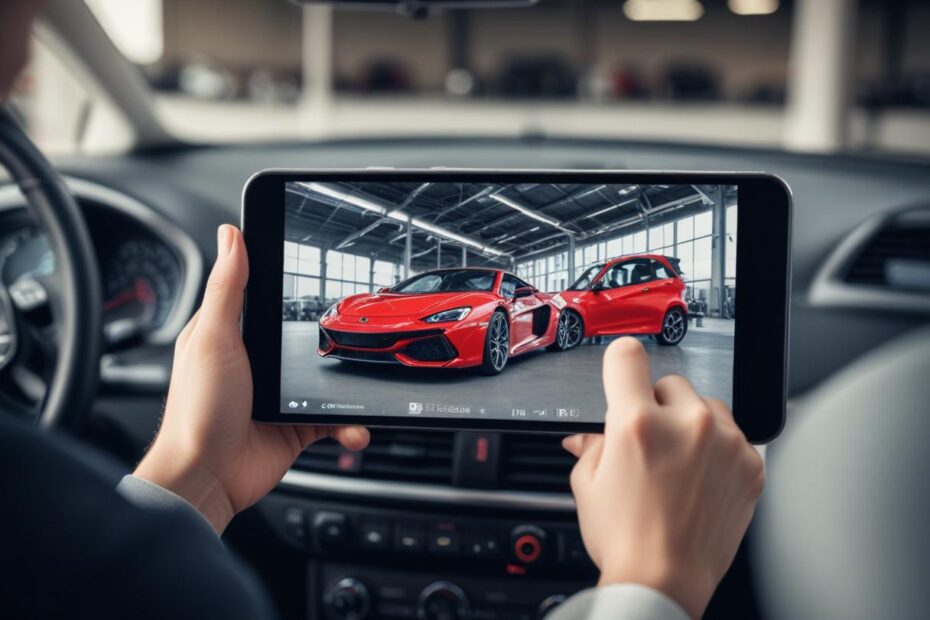Outline for Driving Innovation: Video Commerce Solutions for the Automotive Industry
Embracing video commerce solutions in the automotive industry not only enhances customer engagement but also revolutionizes the way dealerships connect with potential buyers. Imagine a world where a virtual test drive is just a click away, allowing customers to experience vehicles from their own homes. By integrating live interaction features, dealerships can offer real-time Q&A sessions alongside video showcases, turning passive viewers into active participants in their purchasing journey. This dynamic approach fosters an emotional connection that traditional methods simply cannot achieve.
Moreover, leveraging user-generated content within these video platforms can amplify authenticity—customers sharing their experiences and reviews create a powerful sense of community around specific makes and models. Automotive brands that encourage such content not only enhance trust but also build vibrant ecosystems where consumers feel valued and heard. As the landscape of retail continues to shift towards digital-first strategies, it becomes clear that adopting innovative video commerce solutions is no longer just an option; it’s essential for staying ahead in this competitive market.
1. Introduction: Embracing Video Commerce Revolution
User-generated content (UGC) is transforming the landscape of video commerce in the automotive industry, providing an invaluable touchpoint of authenticity that resonates deeply with consumers. When customers share their firsthand experiences through videos—be it a detailed review of a new vehicle or a testimonial about their service interactions—they become credible advocates for brands. This organic content not only fosters trust but also builds community around shared passions, making potential buyers feel more connected to both the products and each other.
Moreover, embracing UGC encourages a cyclical flow of content creation where satisfied customers can inspire future buyers while driving brand engagement without substantial marketing costs. By showcasing real people interacting with vehicles—be it through unboxing, personal testimonials, or even ride-along reviews—brands benefit from relatable narratives that traditional advertising often lacks. In this immersive digital age, companies can tap into this wave of authenticity to humanize their marketing efforts and strengthen customer loyalty, creating a relationship built on genuine dialogue rather than mere transactions.
2. Understanding Video Commerce in Automotive Sector
Embracing User-Generated Content (UGC) in the automotive sector not only nurtures authenticity but also creates an organic cycle of engagement that benefits both brands and customers. Satisfied vehicle owners eager to share their experiences become genuine brand advocates, producing content that resonates deeply with potential buyers. This real-world testimony often carries more weight than traditional marketing efforts, as prospects are increasingly drawn to peer recommendations over polished advertisements.

Additionally, UGC fosters a sense of community among automotive enthusiasts and owners. As individuals post videos showcasing their new vehicles or detailing service experiences, they inadvertently cultivate inspiration for neighbors and fellow drivers considering similar choices. This symbiotic relationship accelerates brand loyalty while simultaneously turning customers into co-creators, influencing others through narratives that humanize the car-buying journey. The cyclical nature of this exchange not only bolsters credibility for automotive brands but also paves a path for innovative storytelling aligned with customer sentiments and preferences.
3. Benefits of Video Commerce for Dealerships
UGC, or user-generated content, plays a pivotal role in creating a vibrant community for automotive enthusiasts and owners. When individuals share videos of their new vehicles or showcase custom modifications, they invite others into their journey, sparking conversations that transcend geographical boundaries. These authentic stories foster connections among users who share similar passions—whether it’s restoring classic cars or exploring the latest electric models. The excitement captured in these videos often elicits a sense of belonging and camaraderie, as viewers celebrate one another’s achievements and quirks within the automotive landscape.
Moreover, UGC provides valuable insights into real-world experiences with various vehicles, informing potential buyers about performance and reliability beyond commercial marketing claims. When customers witness prompt reactions to vehicle features from fellow enthusiasts rather than polished advertisements, they are more likely to trust the information presented. This organic exchange enriches the ecosystem; participants aren’t merely consumers but active contributors shaping trends and opinions. As communities grow through shared interests in UGC video experiences, both brands and consumers benefit—a self-sustaining cycle that drives innovation while deepening enthusiasm within the automotive sector.
4. Enhancing Customer Experience Through Videos
User-generated content (UGC) serves as a rich tapestry of authentic testimonials and firsthand experiences, allowing potential buyers to navigate the often overwhelming automotive market with greater confidence. As consumers share their journeys—whether it’s tackling mountains in an SUV or commuting through city traffic in a compact car—the insights they provide into real-world performance and reliability become invaluable. These unfiltered narratives not only highlight the strengths and weaknesses of various vehicles but also present relatable scenarios that resonate more deeply than traditional marketing messages.
Moreover, leveraging UGC transforms the buyer’s journey from one fueled by doubt to one grounded in community-driven knowledge. By tapping into peer reviews, video demonstrations, and social media posts, potential buyers gain access to practical advice that can steer them toward informed decisions. This grassroots approach fosters trust; consumers are more likely to believe fellow drivers over promotional slogans crafted by manufacturers. Ultimately, integrating user-generated content into video commerce strategies enriches the automotive narrative—creating a vibrant ecosystem where shared experiences illuminate paths for new ownership and drive brand loyalty amid fierce competition.
5. Effective Strategies for Implementing Video Solutions
Moreover, leveraging user-generated content (UGC) transforms the buyer’s journey from one fueled by doubt into a path grounded in community-driven knowledge. In the realm of video commerce, this shift is especially powerful; potential buyers no longer rely solely on polished advertisements or brand messaging. Instead, they turn to relatable experiences shared by real customers who showcase their honest interactions with automotive products. These authentic narratives provide social proof that not only alleviates uncertainties but also builds trust in the overall purchasing process.
Tapping into peer reviews and testimonials allows consumers to visualize themselves within a community of satisfied owners and enthusiasts. Videos featuring genuine experiences—be it road tests, maintenance tips, or lifestyle integrations—serve as invaluable resources for research and decision-making. This collaborative approach moves the needle further than traditional marketing ever could; it fosters an environment where potential buyers feel empowered and informed, ultimately driving conversions through shared insights rather than mere persuasion. By embracing UGC as part of a broader video commerce strategy, automotive brands can cultivate loyalty while simultaneously enhancing the customer experience at every touchpoint along the buyer’s journey.
6. Case Studies: Success Stories in Action
Tapping into peer reviews and testimonials transforms the car-buying experience from a mere transaction into a vibrant exchange within a community of satisfied owners and enthusiastic advocates. Prospective buyers are not just reading what brands have to say; they’re immersing themselves in the narratives shared by their peers. Engaging video testimonials take this a step further, offering an authentic glimpse into real-life experiences that static text simply cannot convey. Through dynamic visuals and emotional storytelling, consumers can envision themselves behind the wheel, cruising through life alongside others who share their passion.
Furthermore, these visual narratives foster trust and relatability, which are crucial in an industry where buyers crave assurance before making significant investments. A video featuring fellow enthusiasts discussing their favorite features or showcasing memorable road trips complements traditional reviews with compelling imagery and genuine enthusiasm. This creates an emotional connection that bolsters consumer confidence—viewers don’t just see cars; they see possibilities filled with adventure, camaraderie, and joy. By building this sense of community around shared experiences, automotive brands can cultivate loyalty beyond purchase decisions while driving innovation through genuine customer engagement.
7. Future Trends in Automotive Video Commerce
In the automotive industry, where purchases often represent a significant financial commitment, visual narratives serve as powerful tools that transcend traditional marketing methods. By showcasing vehicles in action through compelling video content, brands can create immersive experiences that foster an emotional connection with potential buyers. These narratives allow customers to envision how a car fits into their lives—whether it’s a family road trip or daily commutes—instilling confidence in their purchasing decisions.
Moreover, the relatability of seeing real-life scenarios helps demystify the buying process. When prospective buyers view authentic testimonials and relatable stories from other customers, they’re more likely to trust both the product and the brand itself. This level of transparency is essential; it reassures consumers that they’re part of a community rather than merely transactions in a faceless marketplace. Ultimately, by crafting these engaging video stories, dealerships not only enhance customer engagement but also build lasting relationships built on trust and authenticity—a crucial element needed in today’s competitive landscape.
Conclusion: The Road Ahead for Innovation
Moreover, the relatability of seeing real-life scenarios helps demystify the buying process. When prospective buyers view authentic testimonials and experiences from other car owners, it transforms the daunting task of purchasing a vehicle into a more approachable journey. These genuine narratives not only highlight the vehicles’ features but also showcase how they fit seamlessly into everyday life—whether it’s tackling road trips with kids or navigating urban commutes.
Video commerce solutions leverage this authenticity by turning customer stories into valuable marketing assets. By capturing diverse demographics engaging with their vehicles, dealerships can foster trust and make connections that resonate personally with viewers. This shift towards transparency empowers buyers, enabling them to visualize themselves in similar situations which ultimately influences their decision-making process. In an era where consumers crave connection and authenticity, showcasing real-world applications of vehicles bridges the gap between curiosity and commitment.
Read more:










